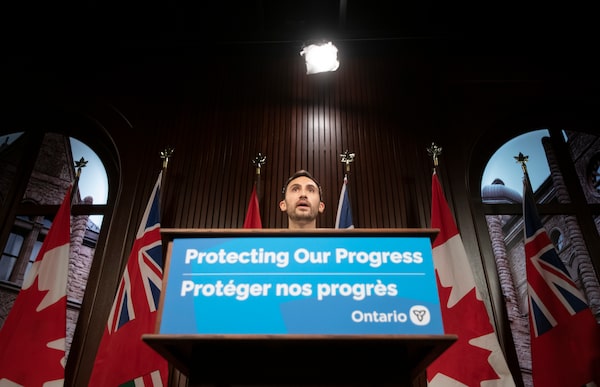
Provincial Minister of Education Stephen Lecce speaks and takes questions at a press conference at the Ontario Legislature on Jan. 12.Fred Lum/The Globe and Mail
Families will be notified by public-health authorities only when their school’s absence rate reaches 30 per cent under new Ontario guidelines.
Schools for the province’s two million students are reopening on Monday amid a surge in COVID-19 cases caused by the fast-spreading Omicron variant – but doctors, parents and educators are divided about a return to in-person learning. The challenge facing public-health officials is balancing the risk of the virus, which is relatively mild in children, with the academic and social harms associated with missing classroom time.
Previously, parents were notified when someone in their child’s classroom tested positive, which would trigger a 10-day isolation period for the exposed cohort. The COVID-19 case – determined by a positive PCR test, which the government has now restricted to the highest-risk settings – would be noted on provincial and school-board websites.
Under the new rules, the province will require principals to report absences to the Ministry of Education, but only when 30 per cent of students and staff are absent will local public-health units be contacted and families notified. It is unclear if the threshold would lead to a school temporarily closing its doors. The province also said it will share information shortly on how parents could access absence data.
Ontario has also shortened the isolation period to five days for children under 12 who develop COVID-19 symptoms. Others who are exposed in a classroom will not have to isolate unless they develop symptoms. The five-day rule also applies to people outside of a school setting who test positive for the virus and are fully vaccinated.
“We have been cautious throughout this pandemic, and we’ve pivoted when required to ensure we protect our schools, our communities,” Education Minster Stephen Lecce told reporters on Wednesday. He added that the government wanted to provide an education to students that “minimizes potential disruption, that protects them and their friends and their families and their educators.”
Mr. Lecce and the province’s Chief Medical Officer of Health, Kieran Moore, said on Wednesday that students and education workers in schools, along with children and staff in daycares, will rely more on rapid antigen tests when they have symptoms of COVID-19. A program the government rolled out late last year that gave students and staff access to take-home PCR tests in their schools will be phased out.
Saskatchewan Premier Scott Moe to not interfere with restrictions to contain Omicron spread
Canadian company behind key COVID-19 vaccine tech inks big development deal with Pfizer
Instead, Mr. Lecce said, the province will provide two rapid tests to elementary students and staff, starting next week. Child-care workers and children in those settings will also receive two rapid tests. High-school students will have access to them as needed. The government said 3.9 million rapid tests are being sent to school boards this week, and another 1.2 million will be shipped next week. More rapid tests will be deployed to child care and schools as they become available, Ministry of Education officials said on Wednesday.
Ontario Premier Doug Ford had said he closed schools to in-person learning for two weeks in the new year because hospitalizations were rising, but also to implement more safety measures and give time for students and staff to get vaccinated. The government said that during the time schools were closed, it shipped N95 masks for school staff and accelerated booster shots for education and child-care workers; as well it is preparing to deploy 3,000 HEPA filters on top of the existing 70,000 already in schools.
The province has also reached an agreement with the Ontario Teachers’ Federation that allows retirees to work for 95 days, up from 50, to address staff shortages.
Cathy Abraham, president of the Ontario Public School Boards’ Association, said that while her organization is pleased to have N95 masks for staff, “we request that the government ensure that school boards are provided with a sufficient supply for as long as is needed to keep our schools as safe as possible.”
Staff and students should have access to PCR tests, she said. “There are many in our school communities who remain concerned about our decreased ability to accurately track cases in our schools.”
NDP education critic Marit Stiles said it makes no sense for schools to have stricter reporting requirements for other conditions and diseases than for COVID-19: “It shouldn’t be easier to find out if there’s a lice outbreak in your kid’s school than a COVID outbreak.”
Asked by reporters why Ontario had not mandated COVID-19 vaccines for students attending public schools – as it has for measles, mumps and a long list of other communicable diseases – Dr. Moore said no other jurisdiction in the country had done so, as the vaccines for children are so new.
Ontario Liberal Leader Steven Del Duca was critical of the remarks and said they play into the hands of the province’s anti-vaccination minority.
Most provinces extended the holiday break or moved students to virtual learning in the new year – an opportunity to enhance layers of protection in schools against the Omicron variant, doctors said.
Schools in British Columbia, Alberta and Saskatchewan have opened their doors to in-person learning, but many are grappling with issues of staff shortages. In B.C., two schools temporarily paused in-person classes because of insufficient staffing levels, just two days after most students returned to classrooms, the province’s Ministry of Education said on Wednesday.
In Ontario, plans are being made to reassign non-teaching staff and non-certified instructors to classrooms if there are not enough substitute teachers to fill the gaps. If the situation worsens, school-board officials are looking at rotating virtual learning days, so that supply teachers could be spread out among the various classrooms. In some cases, individual classes or entire schools could be moved temporarily online.
With a report from Jeff Gray
Our Morning Update and Evening Update newsletters are written by Globe editors, giving you a concise summary of the day’s most important headlines. Sign up today.
 Caroline Alphonso
Caroline Alphonso